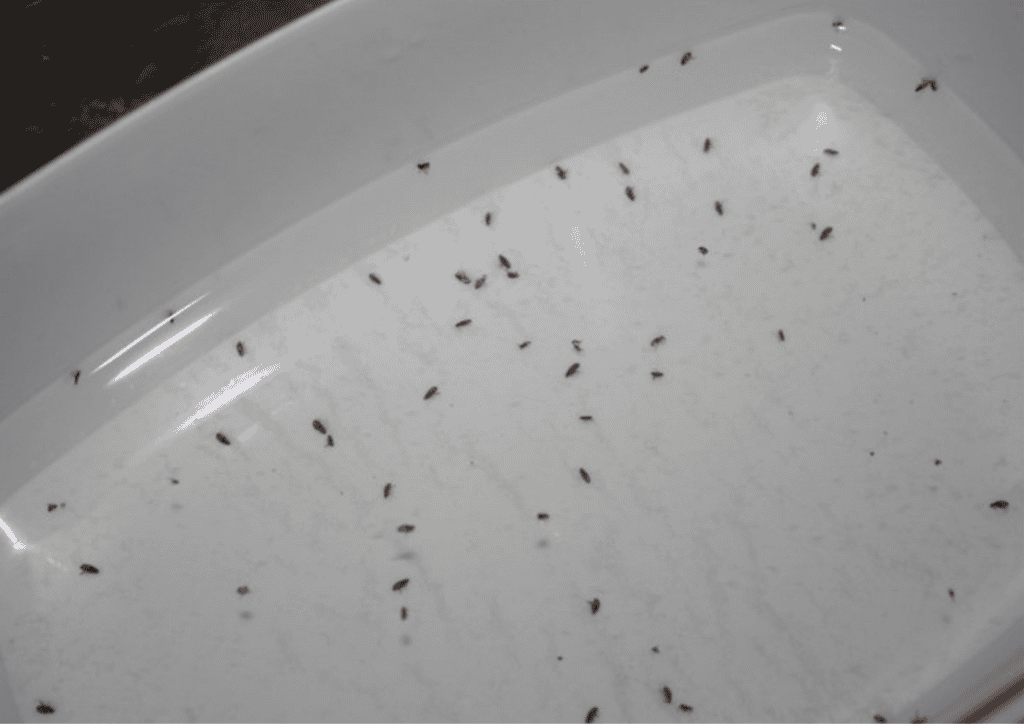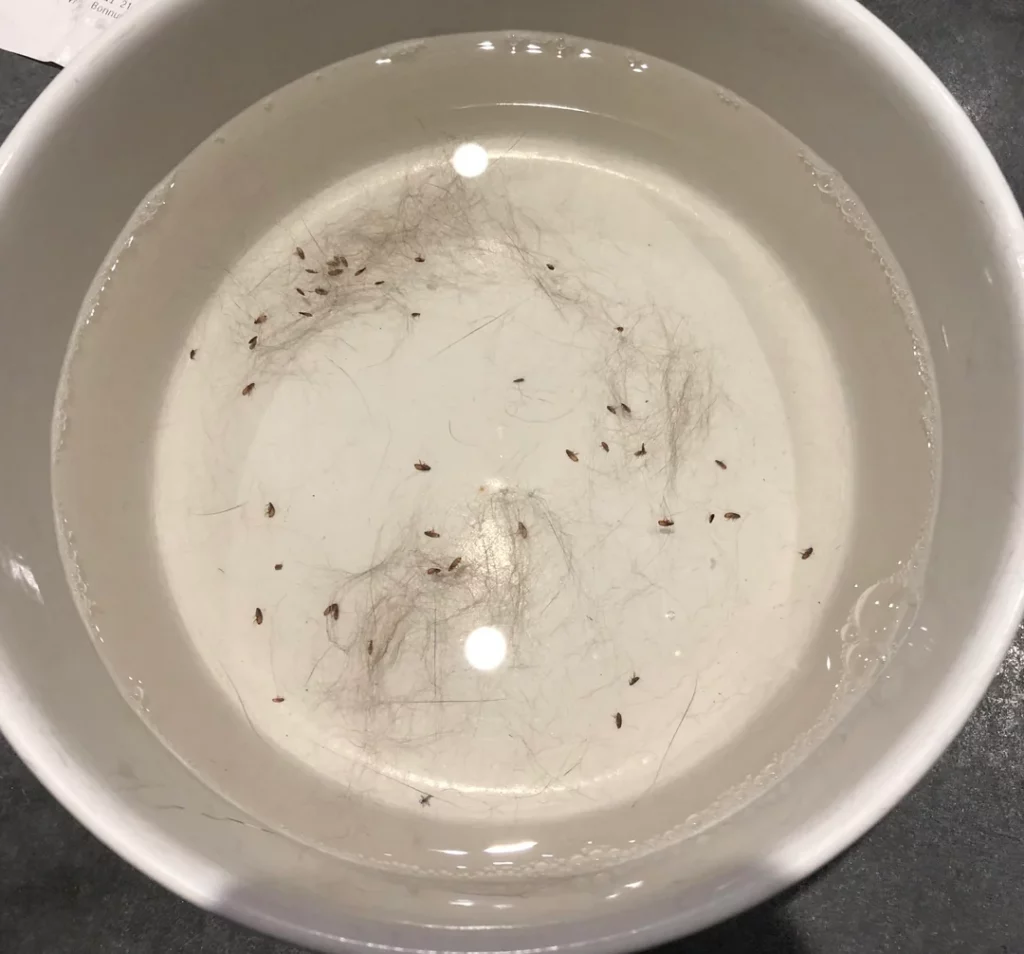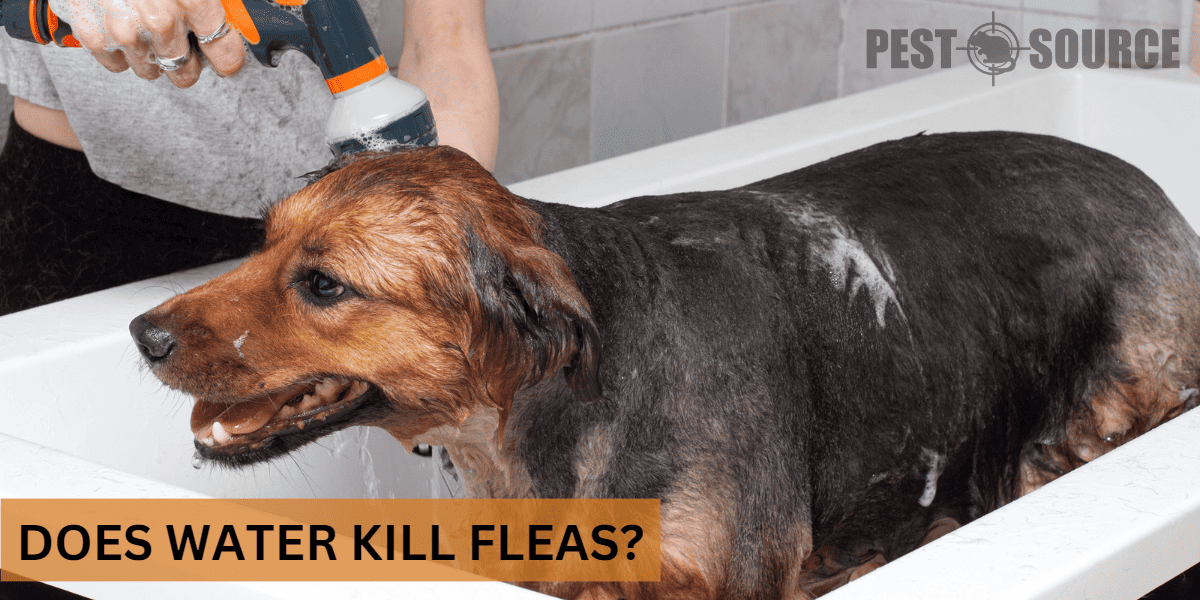Are you tired of dealing with flea infestations and looking for alternative ways to eliminate these pesky pests? You may have heard about using water to kill fleas, but does it really work?
In this comprehensive guide, we’ll explore the relationship between fleas and water, discussing whether water can truly drown fleas, how fleas interact with water, and the practical applications of using water as a flea control method. By examining the effectiveness and limitations of water as a means to control flea populations, you can make an informed decision about the best approach to handle these nuisances in your home and on your pets.
POINTS
- Water, particularly soapy water, can effectively kill fleas by drowning them, as the soap disrupts their ability to float and reduces the surface tension of the water.
- Fleas cannot breathe or survive underwater for long periods, making submersion in water an effective method for killing individual fleas.
- Drowning fleas is more effective when used in combination with other flea control methods, as it may not be efficient in handling all stages of the flea life cycle or large-scale infestations.
- Giving your pet a bath with flea shampoo can help kill fleas on their body, and washing your pet’s bed regularly can assist in reducing flea populations in their sleeping area.
- While drowning is an effective method for killing individual fleas, it is essential to use a comprehensive approach targeting all flea life stages and including regular cleaning, pet treatments, and insecticides when necessary to successfully eliminate and control flea infestations.
Can Fleas Survive in Water?
Is it possible for fleas to drown?

Yes, it is possible for fleas to drown in water. Although these tiny, wingless insects are resilient and can survive in various conditions, submerging them in water for an extended period can lead to their demise.
Can fleas breathe underwater?
Fleas cannot breathe underwater. Like other insects, fleas rely on a respiratory system that uses tiny tubes called tracheae to deliver oxygen directly to their cells. When submerged in water, the tracheae become filled with water, preventing the fleas from obtaining the oxygen they need to survive.
Can fleas hold their breath and, if so, for how long?
Fleas do not have the ability to hold their breath like humans or other animals. Once their tracheae are filled with water, they cannot obstruct or control the flow of water into their respiratory system, leading to suffocation.
Do fleas survive in water and can they live underwater?
Fleas cannot survive in water for extended periods, nor can they live underwater. Although they may temporarily escape water on some occasions, long exposure to water will ultimately lead to their demise. It is not an ideal environment for them, and can negatively affect their life cycle.
Does water kill fleas?

Water can indeed kill fleas, especially when combined with soap, which disrupts the flea’s ability to float on the water’s surface. This makes it more likely for them to drown. The table below outlines key differences in how water and soapy water impact fleas, providing insights into why soapy water is a preferred option for flea control.
| Aspect | Water Alone | Soapy Water |
|---|---|---|
| Surface Tension | Higher, allowing fleas to float | Lower, causing fleas to sink |
| Impact on Flea’s Buoyancy | Fleas can stay afloat | Disrupts flea’s ability to float, leading to drowning |
| Effect on Flea Lifecycle | Less effective on eggs, larvae, and pupae | More effective, especially with thorough application |
| Additional Benefits | None specific | Soap can break down flea exoskeleton, enhancing effectiveness |
How Do Fleas Interact with Water?

Do fleas like water?
Fleas do not particularly like water. They thrive in warm, dark, and humid environments, which are typically found in the fur of pets, carpets, and furniture. Water, especially cold or soapy water, can be dangerous to fleas and may deter them from infesting a certain area.
Can fleas swim?
Fleas cannot swim in the traditional sense, but they can move through water. They have strong hind legs that they primarily use for jumping and navigating through their host’s fur. When in water, fleas can use these legs to move around, but their limited mobility in water makes them more vulnerable to drowning.
What happens to a flea when it comes in contact with water?
When an adult flea comes into contact with water, it will attempt to escape by jumping or navigating through the water. If it cannot escape and becomes submerged, it will eventually die due to suffocation from the water-filled tracheae. In the context of the flea lifecycle, each stage reacts differently when in contact with water.
The following table provides an overview of how each stage of the flea life cycle is impacted by exposure to water and soapy water, offering insights into the holistic approach needed for effective flea control.
| Life Cycle Stage | Impact of Plain Water | Impact of Soapy Water |
|---|---|---|
| Eggs | Minimal impact; eggs are resistant to water | Slightly more effective due to soap’s ability to break down protective layers |
| Larvae | Can disrupt movement but may not kill | Increased mortality due to reduced surface tension and potential ingestion of soap |
| Pupae | Highly resistant; water has little effect | Soap may penetrate cocoon slightly better but still limited effectiveness |
| Adult | Can drown but may take up to 24 hours | Rapid drowning due to reduced buoyancy and compromised exoskeleton |
How do fleas react to being in water?
Fleas will typically try to avoid water and seek out dry, warm environments instead. When forced into a watery environment, fleas will attempt to escape the water by jumping, utilizing their strong hind legs. If submerged without any means of escape, the flea will eventually die due to suffocation.
The Time Frame Required to Drown Fleas
Understanding the time frame required to drown fleas is crucial for effectively utilizing water as a method for flea control. The table below provides a comparison of how long it takes for fleas to drown in plain water versus soapy water, under various conditions.
| Condition | Time to Drown in Plain Water | Time to Drown in Soapy Water |
|---|---|---|
| General | Up to 24 hours | A few minutes to an hour |
| Temperature Variations | Depends on water temperature; colder water may slow the process | Less affected by temperature due to the soap’s effect on flea buoyancy |
| Flea Size | Larger fleas may take longer | Size less significant due to soap disrupting surface tension |
How long does it take for a flea to drown in water?
The amount of time it takes for a flea to drown in water can vary depending on several factors, such as water temperature and the flea’s size. Generally speaking, a flea can drown in water within 24 hours if continuously submerged. Fleas can survive for shorter periods underwater, but ultimately, they will die if they cannot escape the water.
How long can fleas survive underwater?
Fleas can survive underwater for up to several hours. However, the longer they remain submerged, the lower their chances of surviving become. Their ability to survive underwater is significantly reduced, and continuously drowning them will ultimately lead to their death.
How long does it take for fleas to drown in soapy water?
Soapy water can be more effective in drowning fleas than plain water. The soap reduces the surface tension of the water, making it harder for fleas to stay afloat. As a result, fleas can drown much faster in soapy water—typically within just a few minutes to an hour.
The Use of Soapy Water Against Fleas
Can you drown a flea in soapy water?

Yes, you can drown a flea in soapy water. Soapy water is actually more effective in killing fleas than regular water, as the soap weakens the flea’s ability to float on the water’s surface and makes it more likely to become submerged and drown.
Does soapy water kill fleas more effectively than regular water?
Soapy water does kill fleas more effectively than regular water. The soap molecules reduce the water’s surface tension, which causes fleas to sink more easily and makes it more difficult for them to stay afloat. Additionally, the soap can interfere with the flea’s exoskeleton, making it easier for the flea to become submerged and drown.
How does the soap contribute to the killing of fleas in water?
Soap contributes to the killing of fleas in water by disrupting their ability to float on the water’s surface, causing them to become submerged more easily. Additionally, the soap can break down the waxy protective layer on the flea’s exoskeleton, allowing water to enter their respiratory system and drown them more quickly.
Practical Applications of Drowning Fleas
How to drown fleas effectively?

To drown fleas effectively, follow these steps:
- Fill a large container with soapy water. Use a mild, non-toxic soap that can create plenty of bubbles.
- If you notice a flea on your pet or in your home, try to catch it and immediately put it in the soapy water.
- Leave the flea submerged in the soapy water for at least an hour to ensure it drowns.
- Repeat this process whenever you see fleas until you no longer notice any flea activity.
Can you drown fleas on a dog or cat?
Although it’s possible to drown fleas on a pet, it’s not the most practical method for eliminating fleas. However, giving your pet a bath using a flea shampoo specifically designed for this purpose can help drown and kill fleas on their body. Make sure to follow the instructions for the flea shampoo and consult with your veterinarian if you have any concerns.

How often should you wash a pet’s bed to help get rid of fleas?

To help get rid of fleas, it’s essential to wash your pet’s bed regularly. Aim to clean the bed once a week or more often if you notice signs of infestation. Use hot water and a mild detergent, and dry the bedding thoroughly on high heat. This will help kill fleas and their eggs, larvae, and pupae, making your pet’s sleeping area less hospitable for these pests.
The Efficacy of Drowning as a Method to Control Flea Populations

Is drowning an effective method for killing fleas?
Drowning is an effective method for killing individual fleas, especially in soapy water. However, relying solely on drowning as a method to control flea populations may not be practical or efficient, as fleas reproduce rapidly, and their eggs, larvae, and pupae need to be targeted as well. Implementing a combination of flea control methods, which may include using flea treatments, vacuuming, and maintaining a clean environment, will increase your chances of successfully controlling a flea infestation.
Will water kill fleas in significant numbers to be a viable control method?
Water, particularly soapy water, can kill fleas in significant numbers when used properly. However, using water to kill fleas is most effective as a supplementary measure in combination with other flea control methods, especially when dealing with large infestations. To successfully eliminate a flea population, target all stages of their life cycle (adults, eggs, larvae, and pupae) using a comprehensive approach that includes regular cleaning, treating your pet with veterinarian-approved products, and applying insecticides when necessary.
What are the limitations and challenges of using water to kill fleas?
While water can be an effective tool for dealing with fleas, there are certain limitations and challenges:
- Partial solution: Drowning fleas on its own may not adequately address the entire infestation, as eggs, larvae, and pupae may still be present in the environment and may lead to a recurring problem.
- Spot treatment: Using water to kill fleas can be effective for isolated situations or spot treatments; however, it is not as practical for large-scale infestations.
- Accessibility: Fleas may hide in areas where it may be difficult to effectively use water for drowning them, such as cracks in the floor, deep within carpets, or on your pet’s body.
- Time-Consuming: The process of drowning fleas, especially in large numbers or across various life stages, can be time-consuming. This method requires constant monitoring and repeated applications, which may not be practical for busy pet owners or for those seeking immediate results.
- Environmental Conditions: Water’s effectiveness can be influenced by environmental conditions. For example, high humidity levels can prolong the life cycle of fleas, making them more resilient to drowning. Additionally, outdoor environments, where water may quickly evaporate or not reach deeply hidden fleas, can limit the practicality of using water as a control method.
Conclusion
Water, especially soapy water, can be a useful tool in the battle against fleas. However, it’s important to recognize that drowning fleas should be part of a more comprehensive approach to flea control. By combining drowning with other preventative measures and targeted treatments, you’ll have a greater chance of successfully eliminating these unwanted pests from your home and keeping your pets healthy and comfortable.



